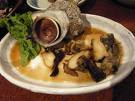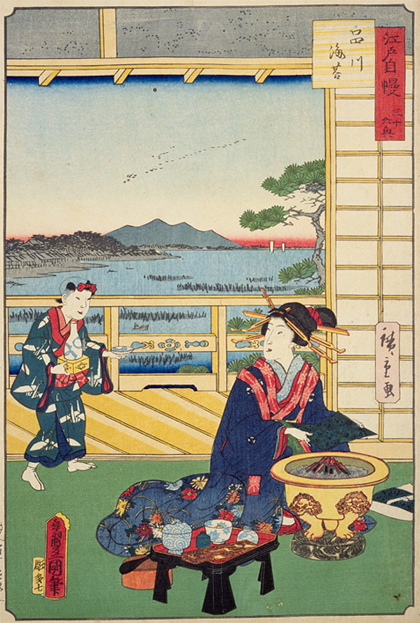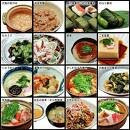[ . BACK to WORLDKIGO TOP . ]
::::::::::::::::::::::::::::::::::::::::::::::::::::::::::::::::::::::::::::::::::::::::::::::::::::
Seafood in Winter : FISH
***** Location: Japan
***** Season: Winter
***** Category: Humanity
*****************************
Explanation
. Fishing in all seasons
Some fish names are combined :
kan xyz ... in the cold
fuyu no xyz ... in winter
Fish heavy with eggs come down the rivers to the estuaries to lay eggs,
others come down from the colder northern waters to the southern shores of Japan
ochi xyz ... coming down
:::::::::::::::::::::::::::::::::::::::::::::::::::::::::::::::::::::::::::::::::::::::::::::::::::
Early Winter
Cod hatsu tara 初鱈 (はつたら) first tara of the season
more see below
sand lance in frost, shimofuri kamasu
霜降かます (しもふりかます)
Sea bass coming down (ochi suzuki 落鱸 (おちすずき))
futobara suzuki 太腹鱸(ふとばらすずき)
"sea bass with a big belly"
..... harafuto はらふと "big belly "
Lateolabrax japonicus
smelt, shishamo 柳葉魚 (ししゃも)
the name comes from the Ainu language
. . . CLICK here for Photos !
grilling shihsamo, shishamo yaku ししゃも焼く(ししゃもやく)
They are also often eaten with the roe, komochi shishamo.
Stint
Ainu Food : Shishamo from Mukawacho 鵡川町
:::::::::::::::::::::::::::::::::::::::::::::::::::::::::::::::::::::::::::::::::::::::::::::::::::
Mid-Winter
Flounder in the cold, kangarei 寒鰈(かんがれい)
shimotsukigarei 霜月鰈 (しもつきがれい) flounder in december
(
shimotsuki, "month with frost", name of the old 11th lunar month)
Gissu coming down, ochi gisu 落鱚 (おちぎす)
for Gissu, see below
Yellowtail, first yellowtail, hatsu buri
初鰤 (はつぶり)
for buri, see below
:::::::::::::::::::::::::::::::::::::::::::::::::::::::::::::::::::::::::::::::::::::::::::::::::::
Late Winter
carp in the cold, kangoi 寒鯉 (かんごい)
itegoi 凍鯉(いてごい)freezing carp
kangoi tsuri 寒鯉釣(かんごいつり)fishing for cold carp
Crucian carp in the cold, kan buna, kanbuna 寒鮒 (かんぶな)
Fam. Carassius
kannare 寒馴れ(かんなれ) fish "used to the cold"
kanbuna tsuri 寒鮒釣(かんぶなつり)fishing for cold crucian carp
kogoribuna, kogori buna こごり鮒(こごりぶな)
"jellied crucian carp" dish
dace in the cold, kanbaya 寒鮠 (かんばや)
Japanese dace, haya.
Leuciscus hakonensis. Bartgrundel
Dace in all seasons
Lamprey eel, yatsume unagi 八目鰻
Lampetra japonica
Despite its name, this in not a member of the eel family.
yatsume 八目(やつめ)"eight eyes"
kan yatsume 寒八目(かんやつめ)lamprey in the cold
river yatsume, kawa yatsume 川八目(かわやつめ)
sand yatsume, suna yatsume 砂八目(すなやつめ)
In zoology, lampreys are often not considered to be true fish because of their vastly different morphology and physiology. I also added them with the seafood selection.
Sea bream in the cold, kandai 寒鯛 (かんだい)
fuyu no tai 冬の鯛(ふゆのたい)sea bream in winter
:::::::::::::::::::::::::::::::::::::::::::::::::::::::::::::::::::::::::::::::::::::::::::::::::::
All Winter
Alaska pollack, sukesoodara
助宗鱈 (すけそうだら)
Theragra chalcogramma
..... sukedoo dara 介党鱈(すけとうだら)
"Tara from Sado Island, "Sadodara 佐渡鱈(さどだら)
"fish with roe", mentaigyo 明太魚(めんたいぎょ)
fish roe from Alaska pollack, momijiko 紅葉子(もみじこ)
Alaska-Seelachs, Alaska-Pollack
angler fish, ankoo 鮟鱇 (あんこう)
Lophiomus setigerus
"biwa fish", biwagyo 琵琶魚(びわぎょ)
"old woman fish", robagyoo 老婆魚(ろうばぎょ)
kaseigyo 華臍魚(かせいぎょ), jugyo 綬魚(じゅぎょ)
hanging angler fish up for cutting, anko no tsurushigiri
鮟鱇の吊し切り(あんこうのつるしぎり)
..... especially liked for its raw liver (ankimo)and
ankonabe hodgepodge in winter.
Seeteufel. monkfish
. . . . . and
nabekowashi 鍋破 (なべこわし) great sculpin
Myoxocephalos polyacanthocephalus
Ara, oki suzuki 阿羅(あら)
Niphon spinosus
araami, ara-ami あら網(あらあみ)net for Ara fishing
:::::::::::::::::::::::::::::::::::::::::::::::::::::::::::::::::::::::::::::::::::::::::::::::::::::
bluefish, Japanese bluefish, mutsu 鯥 (むつ)
mutsu no ko 鯥の子(むつのこ) bluefish eggs
Scombrops boops. japanischer Blaubarsch
Cod tara 鱈 (たら) codfish, haddock
tara "snow fish" 雪魚(たら)
"real cod", madara 真鱈(まだら), hondara 、本鱈(ほんだら)
"tara along the beach" isodara 磯鱈(いそだら)
"tara in the open sea", okidara 沖鱈(おきだら)
taraba, place to fish for tara 鱈場(たらば)
tarabune, ship to fish for tara 鱈船(たらぶね)
tara ami, net to catch tara 鱈網(たらあみ)
tarako, roe of the cod 鱈子(たらこ)
tarachiri, hodgepodge with tara 鱈ちり(たらちり)
tarajiru, soup with tara 鱈汁(たらじる), dongarajiru 寒鱈汁(どんがら汁)
:::::::::::::::::::::::::::::::::::::::::::::::::::::::::::::::::::::::::::::::::::::::::::::::::::::
Dolphin, iruka 海豚 (いるか)
lit. "pig of the sea"
ma iruka 真海豚(まいるか)oceanic dolphin
gondoo kujira ごんどう鯨(ごんどうくじら)
hunting for dolphines, irukagari 海豚狩(いるかがり)
Delphin, dorufin ドルフィン
伸び上りドルフィン首を振れば春
nobiagari dorufin kubi o fureba haru
when the dolfin comes out
and stretches its head -
it is spring
Arima Akito 有馬朗人
:::::::::::::::::::::::::::::::::::::::::::::::::::::::::::::::::::::::::::::::::::::::::::::::::::::
Gissu, dabogisu だぼ鱚 (だぼぎす)
..... gisu ぎす / 義須
Pterothrissus gissu
Globefish, Blowfish (fugu 河豚)
pufferfish, swellfish,
fugu choochin 河豚提燈(ふぐちょうちん)fugu as a lampion decoration
fugu no doku 河豚の毒(ふぐのどく)blowfish poison
fugu atari 河豚中り(ふぐあたり)blowfish poison poisoning
kita makura, kitamakura 北枕(きたまくら)
"death pillow in the north"
harisenbon, hari senbon 針千本(はりせんぼん)
"one thousand needles"
. . . . . and
many more names of this poisonous fish
. . . . . and
fugunabe, blowfish stew 河豚鍋(ふぐなべ)and more food
. . . . . and
fugu tsuri 河豚釣(ふぐつり)fishing for fugu
fugu ami 河豚網(ふぐあみ) net for fishing fugu
Gurnard, hooboo 竹麦魚 (ほうぼう)
Chelidonichthys spinosus
Knurrhahn
. . . . . and another kind of gurnard
kanagashira 方頭魚 かながしら
"gold head", kanagashira 金頭(かながしら)
"fire fish", hi uo 火魚(ひうお)
:::::::::::::::::::::::::::::::::::::::::::::::::::::::::::::::::::::::::::::::::::::::::::::::::::::
Herring, round herring, urume ウルメ, 潤目鰯
big-eye sardine
..... urume うるめ
Etrumeus teres. Urume-Hering
Himeji ひめじ / ヒメジ
Upeneus japonicus
hime ひめ, himeichi, hime-ichi ひめいち
Kintaroo 金太郎(きんたろう)
Kintaroo, the Golden Boy Legend 金太郎
Isaza, isaza 魦 (いさざ) Lake Biwa goby
Gymnogobius isaza and Chaenogobius isaza
eine Grundelart
isazabune 魦舟(いさざぶね)boat for fishing isaza
isazaryoo 魦漁(いさざりょう)fishing for isaza
isaza ami 魦網(いさざあみ)net for isaza
or a special variety,
Neomysis intermedia, almost like small shrimp
isaza eri 魦魞(いさざえり)trap for catching isaza
It grows to about 8 cm in length. Sweetwater fish, often in the lake Biwako, where it is prepared to some delicious dishes.
Some say it is the same as the "white fish", シロウオ shirouo.
. . . CLICK here for Photos !
:::::::::::::::::::::::::::::::::::::::::::::::::::::::::::::::::::::::::::::::::::::::::::::::::::::
Marlin, kajiki maguro 梶木鮪
(かじきまぐろ, 旗魚鮪)
..... kajiki 旗魚
swordfish
fishing for marlin, kajiki tsuri かじき釣り(かじきつり)
Menuke 眼抜 (めぬけ)
menuki めぬき
Sebastes alutus
Alaska Menuke, lives in the colder waters of Northern Japan.
:::::::::::::::::::::::::::::::::::::::::::::::::::::::::::::::::::::::::::::::::::::::::::::::::::::
pomfret, silver pomfret, managatsuo
マナガツオ 真名鰹, (まながつお)
harvest fish
Pampus argenteus
"the real katsuo", fished in the Inland Sea off Sanuki / Kagawa pref.
They call it this way to make sure it is the real KATSUO, not the one eaten in Tosa, at the southern side of Shikoku island.
The fish must be very fresh. To cover its special taste, it is marinated in miso or wine or other sauces for a while.
Its bones are soft and can be deep-fried, served as "bone senbei crackers".
It is also served at the Emperor's palace, prepared as French Food and eaten with knife and fork.
:::::::::::::::::::::::::::::::::::::::::::::::::::::::::::::::::::::::::::::::::::::::::::::::::::::
saffron cod 氷魚 (ひお) hio, lit. "ice fish"
... komai 氷下魚 (こまい) "fish under ice"
... kankai カンカイ(寒海)"cold sea"
Eleginus gracilis
Sandfish, hatahata 雷魚 (はたはた, 鰰, 鱩)
Arctoscopus japonicus
..... "thunder fish", kaminari uo かみなりうお
Speciality of Akita : hata-hata
Sandbandfisch
Sculpin, Japanese sculpin,
杜父魚 (かくぶつ) kakubutsu . 杜夫魚(かくぶつ)
arare uo 霰魚(あられうお)"hailstone fish"
arare gako 霰がこ(あられがこ)
Cottus pollux. (kajika). Kaulkopf
He comes with many local names, for example
gori dishes in Ishikawa.
A kind of anglerfish (anko), see above.
. Sea bream varieties
budai 舞鯛 (ぶだい) "dancing sea bream"
..... maidai まいだい
Calotomus japonicus
. . . . . and
itoyoridai いとよりだい【糸縒鯛】
.... itoyori 金糸魚 (いとより)
itoyouo, ito uo 糸魚(いとうお)"thread fish"
itokuri uo糸繰魚(いとくりうお)
kinsengyo 金線魚(きんせんぎょ)"Golden Thread Fish"
Nemipterus virgatus
. . . . . and
kinmedai 金目鯛 (きんめだい) Alfonsino, "Golden Eye Tai"
nishikidai 錦鯛(にしきだい) "brocade tai"
. . . . .
Shark, same 鮫 (さめ)
Shark 鮫 (さめ) same Haifisch
superorder Selachimorpha
fuka 鱶(ふか)
"blue shark", yoshikirizame 葭切鮫(よしきりざめ)
its fins are used for sharks fin soup
aozame 青鮫(あおざめ)
"star shark", spotted smooth-hound shark, hoshizame 星鮫(ほしざめ)
"tiger shark", torazame 虎鮫(とらざめ)
"cat shark", bullhead shark, nekozame 猫鮫(ねこざめ)
"saw shark", spurdog shark, nokogirizame 鋸鮫(のこぎりざめ)
and many more shark types
:::::::::::::::::::::::::::::::::::::::::::::::::::::::::::::::::::::::::::::::::::::::::::::::::::::
Sole, hirame 鮃 (ひらめ) Bastard halibut
sole in the cold, kanhirame, kanhirame 寒鮃(かんひらめ)
Paralichthys olivaceus. 平目、比目魚, ヒラメ
striped black mullet in the cold
kanbora 寒鰡 (かんぼら)
mekurabora 盲鰡(めくらぼら)"blind bora"
hinode bora 日出鰡(ひのでぼら) "bora at sunset"
Mugil cephalus
Dishes with the springer
. . . . . but
gray mullet, bora 鯔 Mugil cephalus
kigo for autumn
:::::::::::::::::::::::::::::::::::::::::::::::::::::::::::::::::::::::::::::::::::::::::::::::::::::
Tilefish, amadai 甘鯛 "sweet tai"
Okitsudai 興津鯛(おきつだい)sea bream from Okitsu, Shizuoka
guji ぐじ
Lopholatilus chamealeonticeps
Trout surviving (this year) tooshi-ayu 通し鮎 (とおしあゆ)
..... tomari-ayu 止り鮎(とまりあゆ)
More about ayu, masu, trout, sweetfish . . .
Plecoglossus altivelis
.................................................................................
Tuna, maguro 鮪 (まぐろ)
shibi しび, binnaga 鰭長(びんなが)
mebachi めばち / 眼撥 Thunna obesus. big-eyed tuna. großäugiger Thunfisch
"black tuna", bluefin tuna, kuromaguro 黒鮪(くろまぐろ)
... Thunnus thynnus
"real tuna", hon maguro 本鮪(ほんまぐろ)
boat for fishing for tuna, magurobune 鮪船(まぐろぶね)
fishing for tuna, maguro tsuri 鮪釣(まぐろつり)
net for tuna, maguro ami 鮪網(まぐろあみ)
. WASHOKU
Maguro . KIGO and Food
:::::::::::::::::::::::::::::::::::::::::::::::::::::::::::::::::::::::::::::::::::::::::::::::::::::
Whales, kujira 鯨
semi kujira 背美鯨(せみくじら)Eubalaena japonica
makkoo kujira 抹香鯨(まっこうくじら)sperm whale
Physeter macrocephalus
zatoo kujira 座頭鯨(ざとうくじら)humpback whale
Megaptera novaeangliae
iwashi kujira 鰯鯨(いわしくじら)sei whale
Balaenoptera borealis]
nagasu kujira 長須鯨(ながすくじら)
Balaenoptera musculus
..... shironagasu kujira 白長須鯨(しろながすくじら)
kokujira 小鯨(こくじら)"small whale"
isana 勇魚(いさな)Isana. old name for the whale
:::::::::::::::::::::::::::::::::::::::::::::::::::::::::::::::::::::::::::::::::::::::::::::::::::::
Yellowtail, buri 鰤 (ぶり)
Seriola quinqueradiata
big yellowtail, ooburi 大鰤(おおぶり)
"a tonsured goblin", nyuudoo 入道(にゅうどう)
"big fish" ooio 大魚(おおいお)
net for catching yellowtail 鰤網(ぶりあみ)
place for fishing, buriba 鰤場(ぶりば)
salted yellowtail, shioburi 塩鰤(しおぶり)
rolled yellowtail, makiburi 巻鰤(まきぶり)
. . . CLICK here for Photos !
speciality of Noto peninsula
Gelbschwanz
thunder in winter, when the yellowtail are coming,
buri okoshi 鰤起し(ぶりおこし)
Yellowtail is used for the New Year soup (zooni) in Western Japan.
The name BURI is a contraction of ABURA, full of fat, A is left out and BURA becomes BURI.
yellowtail in the cold,
kanburi 寒鰤 (かんぶり)
This one has the most fat and is used in Toyama Bay cooking and Kaga Ryori.
kigo for late winter
Yellowtail of middle-size, warasa (わらさ)
kigo for all autumn
- December 20 -
buri no hi 鰤の日 day of the yellowtail
Created by Radio Nagano.
goroawase with 2 bu 0 ri 「ぶ(2)り(0)
The kanji for the fish has on its right side the kanji for D
ecember 師 (shiwasu).
Other Yellowtail LINKS
Buriwake Shinto Ritual 鰤分け神事
January 1, Shimomura Kamo Shrine, Takaoka, Toyama pref.
buri daikon ぶり大根 yellowtail with radish and more buri dishes from Ishikawa prefecture
..... kaburazushi 蕪ずし salted yellowtail sandwiched between turnips
Hakata Zooni, Hakata Zoni soup with yellowtail
rolled yellowtail, makiburi 巻鰤(まきぶり) from Akita prefecture
buri no shirako ぶりの白子fish roe from yellowtail
BUT
buriko ブリコ, or burikko ぶりっこ the hard roe of the
hatahata fish from Akita
buri tsuru 鰤釣る(ぶりつる)fishing for yellowtailand related KIGO
Yellowtail in the soup for the New Year
"yellowtail tuna to pass into the New Year" toshitori buri 年取鰤 is a speciality for New Year in Western Japan.
hamachi はまち yellowtail, the young fish
kigo for summer
hiketaburi, Hiketa buri ひけた鰤 /引田鰤 a kind of
hamachi
young
buri from Hiketa town
Often the first of the season in Okayama and Kagawa
The market for it startes usually around November 7.
. buri kaido 鰤街道 yellowtail road .
From Wakasa to Nagano
:::::::::::::::::::::::::::::::::::::::::::::::::::::::::::::::::::::::::::::::::::::::::::::::::::::
:::::::::::::::::::::::::::::::::::::::::::::::::::::::::::::::::::::::::::::::::::::::::::::::::::::
eel (capitone) in Italy
The capitone is offered during the Christmas eve dinner which only consists of fish courses.
on the table cloth
the capitone waits
for its turn
Moussia, Italy
Roast Eel, Capitone Arrosto
This is a classic Christmas Eve dish from Altamura, in northwestern Puglia, Italy.
I remember in Germany we also have eel as a favorite winter fish, because of its fat.
In Japan, as we saw above, the eel is eaten in the middle of the summer heat.
Gabi Greve
:::::::::::::::::::::::::::::::::::::::::::::::::::::::::::::::::::::::::::::::::::::::::::::::::::::
sea bream waffles, taiyaki 鯛焼き

stall selling
tai waffles, taiyaki ya 鯛焼屋(たいやきや)
This is a sweet, a kind of waffle or pancake filled with sweet red bean paste and sold at streat stalls, especially during the cold winter days. It has the form of a sea bream, hence the name.
The TAI itself is an auspicious fish, because its word tail, so to speak, is the same as the end of the word MEDE
TAI, auspicious. It is eaten at special ceremonies and the New Year.
white taiyaki 白い鯛焼き is made with tapioka flour, so the waffle stays white. It is more chewy than the normal one. They started to be made in Fukuoka by Fukakusa Tomohiro in 2007. Tapioka flour is sold by Torigoe.
Taiyaki started in 1909 in Asabu juuban, Minato ward, Tokyo. White taiyaki can be served frozen in summer, like a kind of sherbet.
. . . CLICK here for Photos !
Kanda Daruma 神田のたい焼き屋 達磨 with Daruma Taiyaki
... fishing for tai sea bream with a large net, taiami 鯛網
kigo for late spring.
:::::::::::::::::::::::::::::::::::::::::::::::::::::::::::::::::::::::::::::::::::::::::::::::::::
New Year
A lot of fish and seafood is prepared for the special dishes of
the New Year Season, O-Setchi Ryori
(osetchi ryoori おせち料理, 御節料理 )
New Year Food, Neujahrsessen
:::::::::::::::::::::::::::::::::::::::::::::::::::::::::::::::::::::::::::::::::::::::::::::::::::
Fish as Topic
Many contributions in this category might even be considered senryu.
*****************************
Worldwide use
*****************************
Things found on the way
shinkaigyo しんかいぎょ (深海魚) deep-sea fish
in more than 200 meters. Many are caught in the Bay of Suruga.
Tiefseefisch.
There are special sushi shops in Heda and Doi to sell these.
深海魚の寿司 shinkaigyo no sushi!
げほう→トウジン ... gehoo ... toojin. Coelorinchus japonicus
とろぼっち→アオメエソ ... torobotchi ... aome eso 青眼狗母魚. greeneyes. Chlorophthalmus albatrossis
めぎす→ニギス ... megisu ... nigisu. Japanese argentine. Glossanodon semifasciata
どんこ→エゾイソアイナメ ... tongo ... ezoin ainame 蝦夷磯相甞. brown hakeling. Physiculus maximowiczi
ごそ→ハシキンメ ... goso ... hashikinme. "golden eye" . Gephyroberyx japonicus
赤かさご→シロカサゴ ... akasago ... shiro kasago . Setarches longimanus .
kasago 笠子 is a rock fish
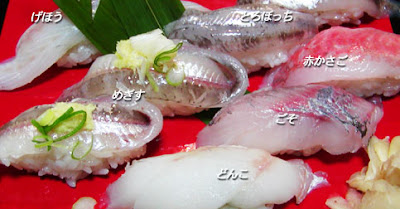
:::::::::::::::::::::::::::::::::::::::::::::::::::::::::::::::::::::::::::::::::::::::::::::::::::::
kengyo 献魚 (けんぎょ) fish as an offering
Fisch als Opfergabe
kengyosai 献魚祭 Ceremony with a fish offering
Especially at Oki no Shima (沖ノ島) and other shrines
*****************************
HAIKU
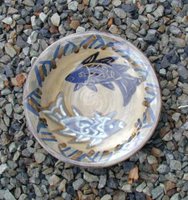 旅人に昨日は岩魚今日は鮎
旅人に昨日は岩魚今日は鮎
tabibito ni kinoo wa iwana kyoo wa ayu
for the traveller
yesterday local trout
today sweetfish
Morita Toge 森田峠
避暑散歩
iwana, Salvelinus pluvius
ayu, Plecoglossus altivelis
*****************************
Related words
Related words
. Food of the New Year Season, O-Setchi Ryori .
(osetchi ryoori おせち料理, 御節料理 )
including fish dishes
.................................................................................
*****
funaryoori 船料理 (ふなりょうり)
food served on board a ship or boat
WASHOKU : SUSHI
Decorations and Vocabulary
*****
WASHOKU : SEAFOOD
. Fishing in all seasons
. "Career Fish"(shusse-uo 出世魚)
They change their name as they grow larger.
. ANIMALS in all SEASONS
SAIJIKI
[ . BACK to WORLDKIGO TOP . ]
:::::::::::::::::::::::::::::::::::::::::::::::::::::::::::::::::::::::::::::::::::::::::::::::::::::









